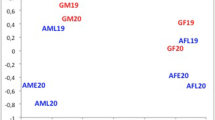Abstract
Sexual dimorphism in the skull of the tiger (Panthern tigris) is reviewed and described in detail. The most significant diagnostic differences between the sexes are absolute length of the cranium, breadth of interorbital region and muzzle, zygomatic arch, and occipital region, length of upper carnassial, and the degree of the development of the cranial prominences. The degree of sexual dimorphism is closely related to geographic variation, and its form is rather complex.
Zusammenfassung
Der Sexualdimorphismus des Tigerschädels wird eingehend beschrieben und diskutiert. Die hauptsächlichen diagnostischen Unterschiede zwischen den Geschlechtern sind die absolute Länge des Schädels, die Breite der Interorbitalregion, der Schnauze, der Jochbögen und der Occipitalregion, sowie die Länge des obere Reißzahns (P4) und die Ausbildung des Scheitelkamms und des Occipi-talkamms (Crista sagittalis und Crista occipitalis). Der Grad des Sexualdimorphismus hängt eng mit der geographischen Variation zusammen, und seine Ausprägung ist ziemlich komplex.
Similar content being viewed by others
References
Hemmer, H. (1969): Zur Stellung des Tigers (Panthern tigris) der Insel Bali. Z. Säugetierkunde 34, 216–223.
Hemmer, H. (1987): The phylogeny of the tiger (Panthern tigris). In: Tigers of the World: The Biology, Biopolitics, Management and Conservation of an Endangered Species. Ed. by R. L. Tilson and U. S. Seal. Park Ridge, New Jersey: Noyes Publications. Pp. 28–35.
Heptner, V. G.; Sludskii, A. A. (1992): Mammals of the Soviet Union. Vol. 2, part 2, Carnivora (Hyaenas and cats). (English translation, Ed. R. S. Hoffmann). Washington D. C.: Smithsonian Institution Libraries and the National Science Foundation.
Herrington, S. (1987): Subspecies and the conservation of Panthera tigris: Preserving genetic heterogeneity. In: Tigers of the World: The Biology, Biopolitics, Management and Conservation of an Endangered Species. Ed. by R. L. Tilson and U. S. Seal. Park Ridge, New Jersey: Noyes Publications. Pp. 51–61.
Hilzheimer, M. (1905): Über einige Tigerschädel aus der Strassburger Zoologischen Sammlung. Zool. Anz. 28, 594–599.
Kitchener, A. C. (1999): Tiger distribution, phe-notypic variation and conservation issues. In: Riding the Tiger, Tiger Conservation in Human-dominated Landscapes. Ed. by J. Seidensticker, S. Christie and P. Jackson. Cambridge: Cambridge University Press. Pp. 19–39.
Mazák, V. (1967): Notes on Siberian long-haired tiger, Panthera tigris altaica (Temminck, 1844), with a remark on Temminck’s mammal volume of the Fauna Japonica. Mammalia 31, 537–573.
Mazâk, V. (1979): Der Tiger Panthera tigris. 2nd ed. Neue Brehm Bücherei 356. Wittenberg Lutherstadt: A. Ziemsen Verlag.
Mazák, V. (1981): Panthera tigris. Mam. Spec. 152, 1–8.
Ognev, S. I. (1935): Zveri SSSR i prilezhashchikh stran. Khishchnyei i lastonogie (Zveri Vostochnoi Evropy i Severnoi Azii) [Mammals of the USSR and adjacent countries: Carnivora and Pinnipedia]. Moscow: Glavpushnina NKVT 3, 1–752 (in Russian).
Pocock, R. I. (1929): Tigers. J. Bombay Nat. Hist. Soc 33, 505–541.
Schwarz, E. (1912): Notes on Malay tigers, with description of a new form from Bali. Ann. Mag. Nat. Hist, series 8, 10, 324–326.
Stroganov, S. U. (1962): Zveri Sibiri. Khischye [Animals of Siberia, Carnivores]. Moscow: Akademiya Nauk SSSR (in Russian, English translation published 1969).
Wentzel, J.; Stephens, J. C.; Johnson, W.; Menotti-Raymond, M.; Pecon-Slattery, J.; Yuhki, N.; Carrington, M.; Quigley, H. B.; Miquelle, D. G.; Tilson, R.; Manansang, J.; Brady, G.; Lu, Z.; Pan, W. S.; Huang, S. Q.; Johnston, L.; Sunquist, M.; Karanth, K. U.; O’Brien, S. (1999): Subspecies of tigers: molecular assessment using ’voucher specimens’ of geographically traceable individuals. In: Riding the Tiger, Tiger Conservation in Human-dominated Landscapes. Ed. by J. Seidenstikker, S. Christie and P. Jackson. Cambridge: Cambridge University Press. Pp. 40–49.
Author information
Authors and Affiliations
Corresponding author
Rights and permissions
About this article
Cite this article
Mazák, J.H. On the sexual dimorphism in the skull of the tiger (Panthern tigris). Mamm Biol 69, 392–400 (2004). https://doi.org/10.1078/1616-5047-00161
Received:
Accepted:
Published:
Issue Date:
DOI: https://doi.org/10.1078/1616-5047-00161




